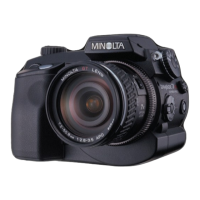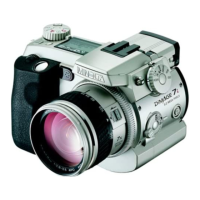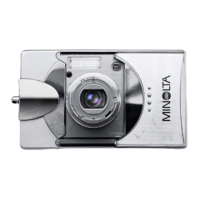62
A
DVANCED RECORDING
BRACKETING
This mode makes a three image bracket of a scene. Bracketing is a method of taking a
series of images of a static subject in which each image has a slight variation in
exposure. The camera is not limited to exposure brackets, but can also make contrast,
saturation, and filter brackets. Only one image characteristic can be bracketed at a
time. The bracketing mode is set with the function dial (p. 48).
Turn the function dial to the drive-mode position (1).
While pressing the function button (2), turn the control
dial (3) to set the bracketing mode.
The order of the exposure bracket series is normal exposure (as indicated by the
shutter-speed and aperture displays), underexposure, and overexposure. The exposure
bracket is set to 0.3Ev increments, but can be adjusted to 0.5Ev or 1.0Ev increments in
the advanced 2 section of the recording-mode menu (p. 80).
Set the contrast, color saturation or filter to the desired level; the bracket series is from
the Digital Effects Control setting to one unit under to one unit over. See the Digital
Effects Control section on page 73 to set the contrast, color saturation, and filter.
Except for a RAW image, if the contrast or color saturation is set to the maximum or
minimum level (±3), one bracket will be made at ± 4: +3, +2, +4. A RAW image cannot
exceed the maximum and minimum levels and will contain two identical brackets: +3,
+2, +3. A black and white Filter bracket is made to the Filter settings before and after
the set Filter (p. 155). If filter 10 is selected, the bracket series will be 10, 9, 0.
Turn the digital-effect switch to the image characteristic to be
bracketed. For more on the Digital Effects Control, see page 73.
Exposure bracket Contrast bracket
Color-saturation bracket Filter bracket
2
1
3
63
If the memory card is filled or the shutter button is released before the series has
completed, the camera will reset and the entire bracket must be made again.
To make a flash bracket, set the digital-effects switch to the exposure position and raise
the camera flash. When using flash, the bracket will not advance automatically; the
shutter-release button must be pressed for each frame of the series. Once the series
begins, the focus and exposure are fixed. The remaining number of frames in the
bracket series is displayed on the monitors next to the bracketing icon.
When exposure brackets are made in S exposure mode, the aperture controls the
bracket. In A and M modes, the shutter speed controls the bracket. The aperure can be
used to control the bracket in M mode by setting the digital-effects switch to the
exposure position and holding the digital-effects button during the exposures. Both the
aperture and shutter speed can control the bracket in P mode.
NOTES ON BRACKETING
Normal
Under
Exposure bracket
Compose the picture as described in the basic recording section (p. 27).
Press the shutter-release button partway down (1) to lock the exposure
and focus for the series; the camera will continue to focus during the
series if set to continuous AF (p. 83). Press and hold the shutter-release
button all the way down (2) to make the bracket series; three consecutive
images will be captured.
1
2
Number of frames in
bracketing series
Frame counter
Over

